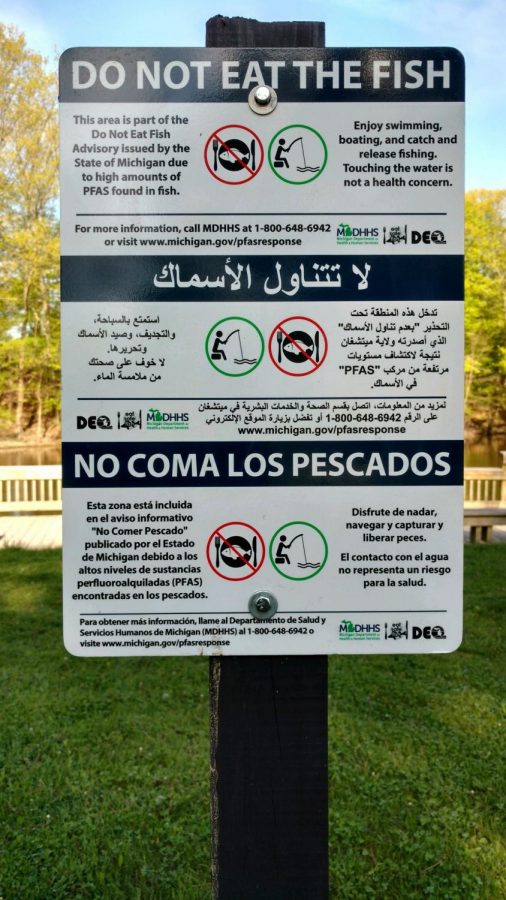Something’s in the water
PFAS levels in Michigan fish soaring, environmental worries for future generations
Just one of the do not eat the fish signs that are speckled along the Huron River.
Warm mornings and dewy evenings show signs for good fishing, especially in Lake Erie.
After fishing for hours, imagine going home to learn the fish you had caught had dangerous levels of Polyfluoroalkyl Substances or PFAS.
Dangerous levels of PFAS means that fish can be no good to eat. So, you have to throw them away and wait for the advisory to be lifted.
Greedy corporations need to begin to realize that their selfish actions have horrendous consequences on all of earth’s creatures, including eventually, them. Just because the horrible results are not known, does not mean that they are non existent. We are allowing these companies to wage chemical warfare against our nation’s people.
PFAS is not only affecting the fish we eat, but the deer we hunt as well. High PFAS levels were also found in deer in Oscoda Township. We know PFAS is there and we know it is dangerous, but what we don’t know is how is it affecting us and where it lurks.
Testing for PFAS is expensive, costing around $300-$600 a test, so to find PFAS is a rarity.
Hidden in the vegetables you eat, the water you drink and the clothes you wear, PFAS lurks everywhere, speckled throughout Michigan.
Military bases and training centers, along with old manufacturing establishments and landfills have some amount of PFAS. Even firefighters can be exposed due to the PFAS in firefighting foam. These chemicals are just another part of a thousand other carcinogens people have to worry about.
Though it is not certain how much PFAS is too much, each state that has set limits on how much is too much. States such as New Jersey are okay with bypassing the amounts they intake. The Agency for Toxic Substances and Disease Registry (ATSDR) has set standards for how much PFAS is okay to take in. The guidelines that have been set are 7 parts per trillion for Perfluorooctane Sulfonate (PFOS) and 11 parts per trillion for Perfluorooctanoic Acid (PFOA.) Whereas, New Jersey is 14 parts per trillion each for PFOA and 13 parts per trillion each for PFOS, according to Circle of Blue, a website dedicated to researching the worlds security of water.
These chemicals that we possibly eat and possibly drink are not only hurting our bodies but are hurting our environment as well. PFAS has been found in 43 states with 610 different destinations and Michigan has been shown to have the most. Michigan alone has 192 destinations that tested positive for PFAS chemicals. How long will we continue to produce untested chemicals and allow them to taint our water supply?
The government needs to make testing of chemicals mandatory. We test the materials that enter our bodies, like drugs and food, which is the FDA’s responsibility, however, they can not protect your safety if we are allowing awful chemicals to just pour into the drinking and eating supply.
PFAS sites are spread all over the nation leaving contaminated foods and water left for us to eat and drink. The effects of PFAS will not only harm us but also our future generations. The effects can include, but are also not limited to, low infant birth weights and can inhibit our immune systems.
This problem does affect you. This is Michigan’s brand new water crisis, at the extremity to which the lieutenant governor felt the need to call a state of emergency for Kalamazoo county as a result of high PFAS levels in the drinking water. Towns like Oscoda have seen major effects. Children can see the PFAS foam wash up on shores and the curious minds will be drawn to it. The effects of touching the foam are not known at the moment, but Michigan’s Department of Health & Human Services (MDHHS) advises that people are not to touch it for it might contain enough PFAS to have some type of long term effect. But residents and local news organizations have been denied the access to public records concerning the amounts of PFAS in the water.
One of the biggest issues about PFAS is how long it can remain within bodies. According to the ATSDR, it takes 4 years for the levels of PFAS within the body to go down by half.
PFAS was created by humans and it surely can be reduced by us, too. The government needs to be more restrictive on where major companies take their waste. PFAS designated sites should be created, secure waste spots where it can be deposited. Those companies that don’t follow, simply need heavy fines. The companies that complain do not care for life quality of you or your family.
Take precautions like buying reusable water bottles that are not made with BPA, avoiding the ones that are. Also, watch what you are throwing away. Household items like batteries (which leak harmful chemicals), paints and motor oil are harmful for the environment and have plenty of other appropriate recycling sites they belong, besides dumpyards. We can use these precautions to help keep more chemical epidemics from happening, so let’s do so








